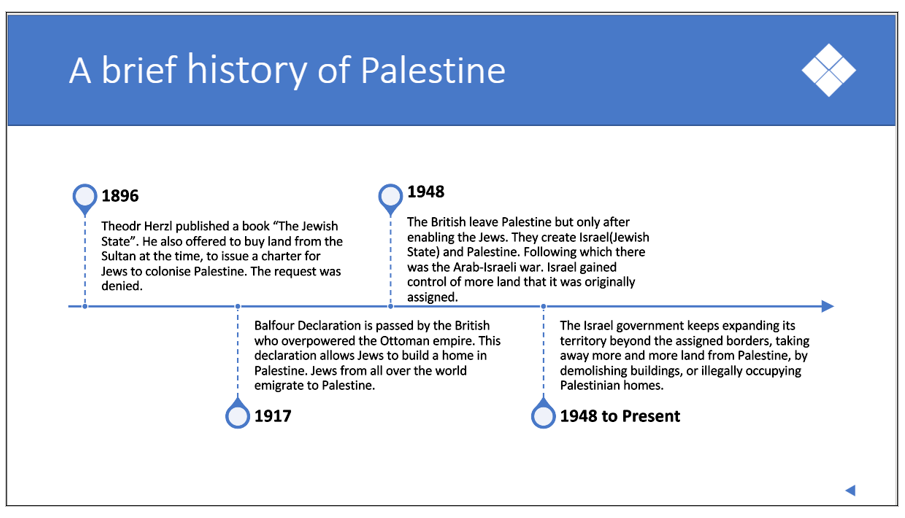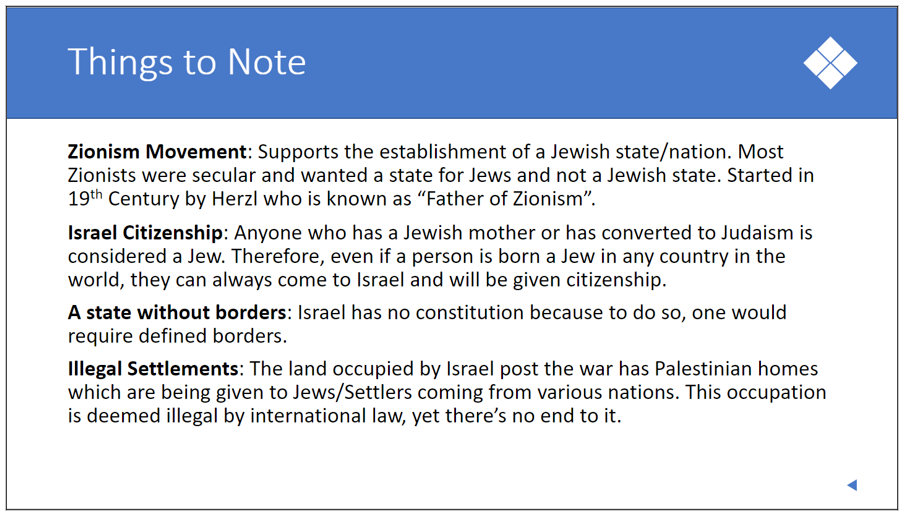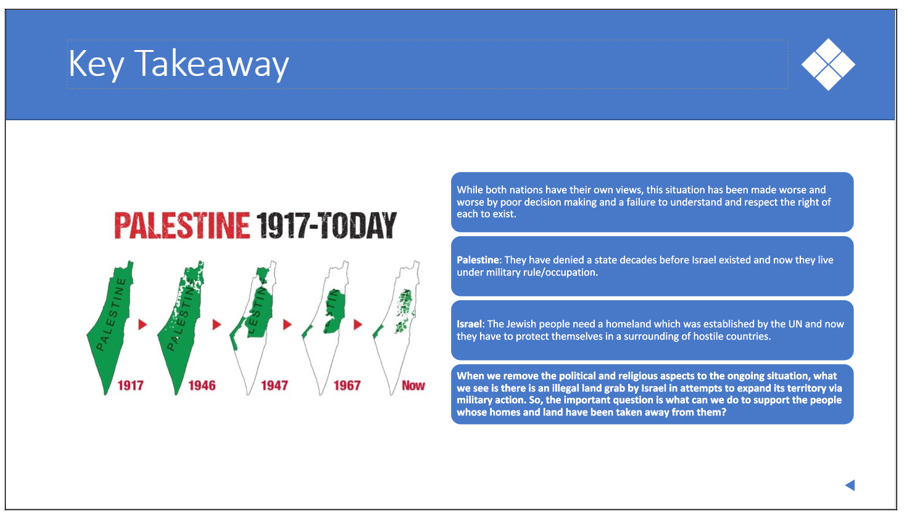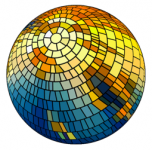Contents (go to): Relevant A1 ¦ Relevant A2 ¦ Planning ¦ Script & Infographic ¦ More Information ¦ Group ¦ Appendix
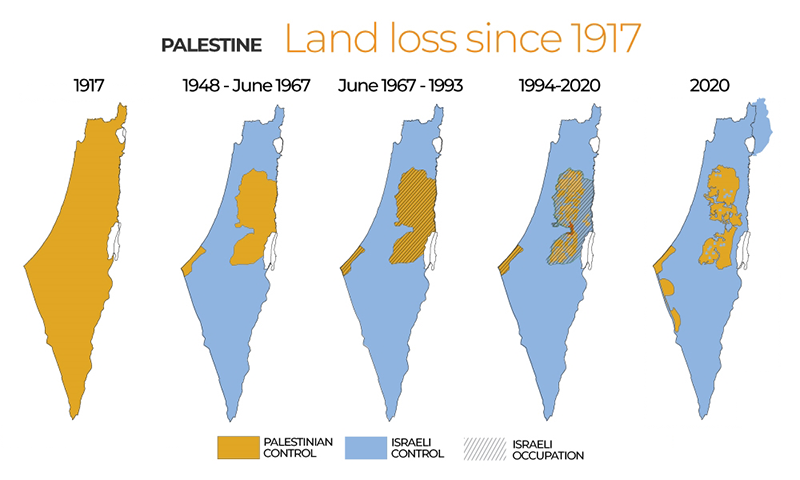
Relevant from Assignment 1
Issues
The main issue that we would like to address through our campaign is not necessarily disinformation – we think there is a lot of reputable information sources available to everyone with internet access – but the conception of the Irish people that they know everything about Israel and Palestine.
We think that very few people, even those involved in the conflict and occupation, fully understand every aspect of it. That is merely because of the nature of these situations, where issues and experiences intersect each other and often contradict one another.
Of course, our opinions on highly politicised issues such as the Palestinian question are shaped by our personal histories, education, and prejudices. Creating an objective section of our campaign, even though we will be advocating on behalf of the Palestinian people, will be important in order to spread information to as wide a variety of people as possible. This will hopefully garner the intergenerational, cross-cultural and cross-ideological support needed in order to run a successful campaign
Information
Information is always an issue when talking about conflict and it raises some of the following questions – Who started it? What is it about? What is being done to fix it?
This piece on the history and facts behind the Palestinian conflict has been a step in helping myself understand what has actually happened in the Palestine conflict. The root of the conflict in Palestine can be traced back as far as world war one, where the British forces took control. The conflict is less about religion (unlike many wars around the world) and more about control of land and territories.
Today, there is still much unrest in east Jerusalem, the west bank and Gaza. Some of the main issues involved in this conflict include whether both sides would share Jerusalem and a Palestine state would be created to be alongside Israel. Several major wars have taken place in this region for example operation Cast Lead in late 2008 and operation Protective Edge in mid-2014.
After 25 years of peace talks, conflict still remains. There have been approximately 5600 Palestinians killed and 115000 injured between 2008 and 2020. By far the most surprising statistic is that in 2018 there were 31,558 Palestinians injured compared to 130 Israeli. 5.6 million Palestinians are registered as refugees and this doesn’t include people who have been displaced but still remain in the region. Refugees that were displaced in 1948 were not allowed to return to the region due to fear of disruption to the sustainable Jewish demographic majority. This allowed the Jewish majority to establish and for the Jewish culture to develop.
Issue of Illegal Settlements
Even without knowing the history and just looking at it through the lens of basic humanity, is it okay to evict people from their own homes, which they invested in and built from scratch – just because of the belief that the land is God gifted?
Nevertheless, this is what continually happens every day. Settlers illegally occupy Palestinian homes, and the ones that come in the way are demolished. It’s easy for Jews to build homes, get property and obtain citizenship, but once a Palestinian leaves, they can never come back. It is hard for them to even exist in their own homes. These actions are against international laws, and yet they continue to happen.
Relevant from Assignment 2
Human Rights Approach
According to the United Nations Sustainable Development Group, a human rights-based approach is “a conceptual framework for the process of human development that is normatively based on international human rights standards and operationally directed to promoting and protecting human rights”. International human rights are universal, directly applicable to all individuals, and are expected to be upheld by all.
In this regard, we sought to answer three questions.
- What is happening in the illegal settlements in the West Bank and how can we raise awareness about it?
- What human rights are being violated in the illegal settlements?
- What can we do to help prevent the abuse of human rights?
Human rights are a form of protection. Often, we are not aware of all of our rights, especially so until they are violated.
Reasoning
From the beginning of our group discussions, we wanted to understand (or at least be able to illustrate effectively) how one day, one country can decide to call another their own. We immediately recognised the shattering effects that such a decision would have on both countries, and we could not imagine being in a situation where our homes were no longer our own. Given that the land and livelihoods of the Palestinian people weren’t protected, we wanted to explore what forms of discrimination were being experienced.
As with any armed conflict, the development of a region draws to a near halt, and citizens are exposed to war crimes and crimes against humanity. We found that the freedom of movement of Palestinians was restricted, that they were forcibly evicted, and subjected to torture and ill-treatment, culminating in various human rights violations and deteriorations of women’s rights, the rights of LGBTQI+ people’s, refugee and migrant rights, and the right to health (Amnesty International).
Implications on Implementation
We were aware from the outset of our learning journey that different opinions exist about Palestine and Israel. These differences stretch across political, religious, cultural, and historical dynamics, each facet of which cannot often be separated from another. We believed that in order to remain focused on the situation in the West Bank and to not get distracted by the opinions of competing interest groups, that we should place a strong emphasis on humanity. This meant that no matter what complication we encountered, to the forefront of our minds was always the impact of Israeli decisions on the Palestinian people.
By focusing on human rights violations, how they are being perpetrated, and what can be done to prevent such abuse, we were able to conceptualise an informative campaign with a call for boycotting products produced in the illegal settlements, thus remaining absent from engagement with any conflicting views.
Sustainable Development Goals Approach
We believe the SDGs is one of the most important approaches. If we were to look at the conflict in Palestine from the view of how it hinders the development and success of the SDGs and how this region cannot aim to achieve the goals while there is such conflict in the area. we also want to look at specific goals and how they are not only not being met but are actively being denied.
This project was a tricky one as there are so many angels to look at it from. However, we think the sustainable development goals join everything together as we believe the SDGs involve every aspect of humanity and the world. An example of how Palestine are being denied basic human rights linked to the SDGs is water consumption. Israel control most of the water supplies in the region so it is near impossible for Palestine to have access to clean water. This is a direct consequence of the conflict in this region.
In 2016 the Palestinian council of ministers formed a task force to implement the SDGs and coordinate the national efforts. However, there a number of indicators showing that this hasn’t worked; 29.2% of people in this region are living below the poverty line. That is almost a third of people. The Gaza strip is particularly affected with 53% of people described as “poor”. Education has also declined, with it no longer contributing towards obtaining a decent job. Unemployment, specifically for people who have graduated, has settled around 35%. This, again, is an indicator that Palestine isn’t (and can’t possibly) achieve goals 1 (No poverty) and goal 4 (Quality education). Many Palestinians have had to flee their home and have set up in refugee camps. This makes SDG 11 (Sustainable Cities and Communities) almost impossible as there are little cities and communities left to work with.
The implications of the above is simple. It is very clear that the sustainable development goals can’t possibly be met and that they are actively being written off. By looking at our project from this position, we can see the negative impact that this conflict, is not only having on Palestine, but also on the rest of the world. we believe this approach has also helped us develop our project and see a new perspective. By taking the SDGs into account when learning and contributing to Trócaire’s campaign, we are able to have a global perspective and think about the global impacts of this terrible conflict.
Planning
In the global citizenship and development education module, we learnt about the various aspects of the ongoing tensions in Palestine. As the course nears its end, it’s our job to make sure we share this knowledge and do what we can to help global citizens. The method assigned to us was campaigning, so our first job was to understand what campaigning meant.
With the help of Dr Rola (Hamed) Abu Zeid, Dr Gertrude Cotter, and various resources from the internet, especially the Trocaire campaign website, this we what we learnt about campaigning:
- Choose a particular topic and be specific – Illegal Settlements in Palestine.
- Be knowledgeable about the chosen topic – Why settlements are illegal? Why shouldn’t we support it? What campaigns are in place for the same?
- What are our clear objectives/aims? – Spreading awareness about illegal settlements and getting signatures for the campaign Trocaire is running for the same.
- How are we going to achieve the same? – Creating infographics having the required information and sharing them across social media to get signatures for the campaign.
- Who is the targeted audience? – Our classmates, UCC students/staff.
- How are we going to measure our success? – Every person who asks a question is intrigued, and even if they don’t, we have captured their attention for at least a few moments. We could keep a record of who signed, digitally or manually.
Once we understood what campaigning was, all that was left was defining tasks, delegating them, and setting timelines.
We created an action plan for the same and below are the identified risks and solutions.
Action plan
| Possible Challenges | Solution |
| People may not do their parts and meet deadlines which could delay the work. | Keep communication within the group active and motivate the team throughout. |
| Challenge to keep the message clear while not compromising or being overwhelmed by information. | Run the material and ideas through everyone, take suggestions, work as a team, and get feedback from mentors/teachers. |
Script & Infographic from Social Media Campaign
This post involves a European Citizens Initiative, so is FAO citizens of the EU who are old enough to vote in European Parliament elections. If you do not qualify, you may still be interested to read and research how your country is trading with the occupied West Bank.
This semester, we began an extra module with University College Cork as part of my course. The module was entitled ‘Global Citizenship and Development Education’ and has explored these concepts and others such as colonialism and human rights. We are required to conduct a group project which is action-orientated and result-driven. We need to quantify our results, so if you sign the European Citizens Initiative as outlined below, please comment on this post to let us know.
My group has been learning about Palestine and Israel and we were tasked with creating a campaign in support of Palestinian people living in the West Bank. We heard from Trócaire about illegal settlements which can be residential, agricultural or business developments that are built on land outside of a country’s internationally recognised borders, and about the Occupied Territories Bill which is proposed legislation before the Oireachtas since 2018, that seeks to ban trade between Ireland and “territories where there is a clear international legal consensus on the status of the occupation” (Trócaire, 2019). The ICJ has confirmed Israel’s illegal settlements in the West Bank of Palestine as occupied. As such, if the bill is passed, it will not involve a boycott of all Israeli goods, only the importation and sale of goods which are produced in the West Bank. If you would like to read more about this, you can do so here: https://lnkd.in/gSaJ2eg2
We aimed to raise awareness about these settlements and identify products which can be boycotted prior to the potential passing of the OTB, and to get signatures for the European Citizens Initiative to #StopTradeWithSettlements. Your signature would mean that:
- You support the EU ceasing trade with all illegal settlements in occupied territories.
- You call on the EU to apply international law and human rights in trade relations.
- You do not want to be involved (through trade) in the colonisation and violence inflicted on people in occupied territories.
This support would put weight behind the OTB. If you would like to support the Initiative, you can do so here: https://lnkd.in/gbswQKTb
You can also sign using the QR code on the below infographic.
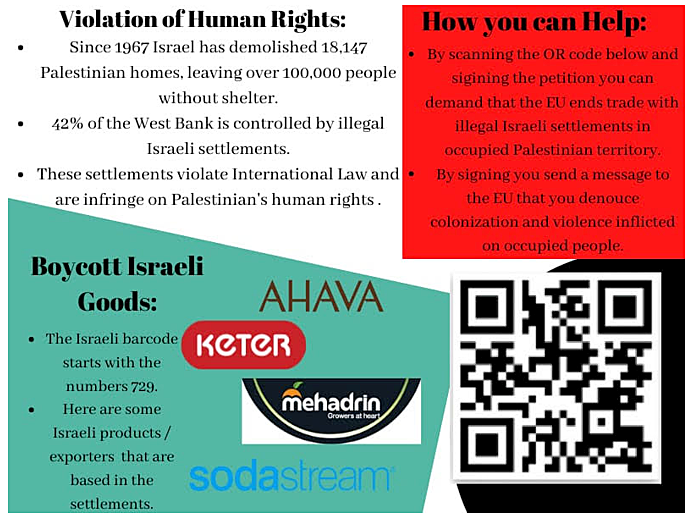
More information
Other information sources that we recommend are:
The Ireland Palestine Solidarity Campaign: https://www.ipsc.ie/
The Israeli Information Centre for Human Rights in the Occupied Territories: https://www.btselem.org/
Al-Haq: https://www.alhaq.org/
Trócaire: https://lnkd.in/gZZudw62
Group participants
- Tresska Fawziya Abullah
- Maeve Theresa Cronin
- Srujani Dash
- Mark Daniel Healy
- Diandra Marie Ni Bhuachalla
Appendix
Here is some useful information from our presentation
